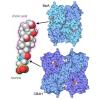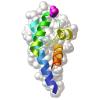Enzymes
the cell's chemists
Enzymes perform all of the basic chemical tasks needed to sustain life. Each binds to its target molecule, performs a chemical change, and then releases the altered molecule. Atomic structures have revealed the atomic-level details of how enzymes work to recognize their substrates and catalyze their chemical reactions.
Molecule of the Month Articles (144)
 |
AAA+ Proteases
AAA+ proteases are ATP-powered molecular motors that thread protein chains through a hole |
 |
ABO Blood Type Glycosyltransferases
ABO blood types are determined by an enzyme that attaches sugars to proteins |
 |
Acetohydroxyacid Synthase
In plants, AHAS performs the first step in synthesis of three essential amino acids, making it an effective target for herbicides. |
 |
Acetylcholinesterase
Acetylcholinesterase stops the signal between a nerve cell and a muscle cell |
 |
Aconitase and Iron Regulatory Protein 1
Aconitase performs a reaction in the citric acid cycle, and moonlights as a regulatory protein |
 |
Alcohol Dehydrogenase
Alcohol dehydrogenase detoxifies the ethanol we drink |
 |
Alpha-amylase
Amylases digest starch to produce glucose |
 |
Aminoacyl-tRNA Synthetases
Aminoacyl-tRNA synthetases ensure that the proper amino acids are used to build proteins |
 |
Anabolic Steroids
Anabolic steroids like testosterone are among the most common performance enhancing drugs |
 |
Aspartate Transcarbamoylase
Key biosynthetic enzymes are regulated by their ultimate products through allosteric motions. |
 |
Assembly Line Polyketide Synthases
Large multienzyme complexes that synthesize diverse small molecules in a stepwise manner. |
 |
Beta-galactosidase
Beta-galactosidase is a powerful tool for genetic engineering of bacteria |
 |
Beta-secretase
Beta-secretase trims proteins in the cell and plays an important role in Alzheimer's disease |
 |
cAMP-dependent Protein Kinase (PKA)
PKA delivers cellular signals by adding phosphates to proteins |
 |
Carbonic Anhydrase
Carbonic anhydrase solubilizes carbon dioxide gas so we can breathe it out |
 |
Carotenoid Oxygenase
Light-sensing retinal molecules are built from colorful carotenoids in our diet |
 |
Caspases
Caspases disassemble proteins during the process of programmed cell death |
 |
Catalase
Catalase protects us from dangerous reactive oxidizing molecules |
 |
Citrate Synthase
Citrate synthase opens and closes around its substrates as part of the citric acid cycle |
 |
Citric Acid Cycle
Eight enzymes form a cyclic pathway for energy production and biosynthesis |
 |
Cyclooxygenase
Aspirin attacks an important enzyme in pain signaling and blood clotting |
 |
Cytochrome p450
Cytochrome p450 detoxifies and solubilizes drugs and poisons by modifying them with oxygen |
 |
Dehalogenases
Bacteria destroy toxic environmental pollutants that include chlorine or bromine atoms. |
 |
Dihydrofolate Reductase
DHFR is a target for cancer chemotherapy and bacterial infection |
 |
DNA Ligase
DNA ligase reconnects broken DNA strands, and is used to engineer recombinant DNA |
 |
EPSP Synthase and Weedkillers
The weedkiller Roundup attacks a key enzyme involved in the construction of aromatic compounds. |
 |
Exosomes
Exosomes destroy messenger RNA molecules after they have finished their jobs |
 |
Fatty Acid Synthase
Fatty acids are constructed in many sequential steps by a large protein complex |
 |
Glucansucrase
Bacteria adhere to our teeth by building sticky sugar chains |
 |
Glucose Oxidase
Glucose oxidase measures blood glucose level in biosensors |
 |
Glutamine Synthetase
Glutamine synthetase monitors the levels of nitrogen-rich amino acids and decides when to make more |
 |
Glycogen Phosphorylase
Glycogen phosphorylase releases sugar from its cellular storehouse |
 |
Glycolytic Enzymes
The ten enzymes of glycolysis break down sugar in our diet |
 |
HIV Reverse Transcriptase
HIV builds a DNA copy of its RNA genome, providing a unique target for drug therapy |
 |
Hydrogenase
Hydrogenases use unusual metal ions to split hydrogen gas |
 |
Hypoxanthine-guanine phosphoribosyltransferase (HGPRT)
Cells salvage and recycle their obsolete DNA and RNA |
 |
Isocitrate Dehydrogenase
Atomic structures have revealed the catalytic steps of a citric acid cycle enzyme |
 |
Lactate Dehydrogenase
Our cells temporarily build lactate when supplies of oxygen are low |
 |
Legumain
Legumain cleaves proteins, and can also put them back together. |
 |
Luciferase
Organisms from fireflies to bacteria use luciferase to emit light |
 |
Lysozyme
Lysozyme attacks the cell walls of bacteria |
 |
Methyl-coenzyme M Reductase
Methanogens use sophisticated molecular tools to build methane |
 |
New Delhi Metallo-Beta-Lactamase
Antibiotics can save lives, but antibiotic-resistant strains of bacteria pose a dangerous threat |
 |
Nitrogenase
Nitrogenase uses an exotic cluster of metals to fix atmospheric nitrogen into bioavailable ammonia |
 |
O-GlcNAc Transferase
Some protein functions are regulated when sugars are attached |
 |
Oxidosqualene Cyclase
Oxidosqualine cyclase forms the unusual fused rings of cholesterol molecules |
 |
Pepsin
Pepsin digests proteins in strong stomach acid |
 |
Phenylalanine Hydroxylase
An unusual cofactor is used in the synthesis of aromatic amino acids |
 |
Phytase
Phytase is used in agriculture to mobilize indigestible phosphate compounds in livestock feed. |
 |
Plastic-eating Enzymes
Researchers are looking to Nature to find ways to dispose of discarded plastic. |
 |
Poly(A) Polymerase
Poly(A) polymerase adds a long tail of adenine nucleotides at the end of messenger RNA |
 |
Pyruvate Dehydrogenase Complex
A huge molecular complex links three sequential reactions for energy production |
 |
Restriction Enzymes
Bacterial enzymes that cut DNA are useful tools for genetic engineering |
 |
Rhomboid Protease GlpG
Some proteases cut proteins embedded in cell membranes |
 |
Ribonuclease A
Ribonuclease cuts and controls RNA |
 |
Ribonucleotide Reductase
Ribonucleotide reductase creates the building blocks of DNA |
 |
Ribosome
Ribosomes are complex molecular machines that build proteins |
 |
RNA Polymerase
RNA polymerase transcribes genetic information from DNA into RNA |
 |
Rubisco
Rubisco fixes atmospheric carbon dioxide into bioavailable sugar molecules |
 |
Selenocysteine Synthase
Selenium is used in place of sulfur to build proteins for special tasks |
 |
Self-splicing RNA
Special sequences of RNA are able to splice themselves |
 |
Src Tyrosine Kinase
Growth signaling proteins play an important role in the development of cancer |
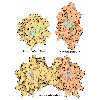 |
Sulfotransferases
Sulfotransferases transfer sulfuryl groups in enzymatic reactions |
 |
Superoxide Dismutase
Superoxide dismutase protects us from dangerously reactive forms of oxygen |
 |
Tetrahydrobiopterin Biosynthesis
Tetrahydrobiopterin plays an essential role in the production of aromatic amino acids, neurotransmitters and nitric oxide. |
 |
Thrombin
Thrombin activates the molecule that forms blood clots |
 |
Thymine Dimers
Ultraviolet light damages our DNA, but our cells have ways to correct the damage |
 |
Tissue Transglutaminase and Celiac Disease
Tissue transglutaminase staples proteins together by forming a chemical crosslink. |
 |
Topoisomerases
Topoisomerases untangle and reduce the tension of DNA strands in the cell |
 |
Transposase
Transposases shift genes around in the genome |
 |
Trypsin
An activated serine amino acid in trypsin cleaves protein chains |
 |
Xanthine Oxidoreductase
Xanthine oxidoreductase helps break down obsolete purine nucleotides |
 |
AAA+ Proteases
AAA+ proteases are ATP-powered molecular motors that thread protein chains through a hole |
 |
ABO Blood Type Glycosyltransferases
ABO blood types are determined by an enzyme that attaches sugars to proteins |
 |
Acetohydroxyacid Synthase
In plants, AHAS performs the first step in synthesis of three essential amino acids, making it an effective target for herbicides. |
 |
Acetylcholinesterase
Acetylcholinesterase stops the signal between a nerve cell and a muscle cell |
 |
Aconitase and Iron Regulatory Protein 1
Aconitase performs a reaction in the citric acid cycle, and moonlights as a regulatory protein |
 |
Alcohol Dehydrogenase
Alcohol dehydrogenase detoxifies the ethanol we drink |
 |
Alpha-amylase
Amylases digest starch to produce glucose |
 |
Aminoacyl-tRNA Synthetases
Aminoacyl-tRNA synthetases ensure that the proper amino acids are used to build proteins |
 |
Anabolic Steroids
Anabolic steroids like testosterone are among the most common performance enhancing drugs |
 |
Aspartate Transcarbamoylase
Key biosynthetic enzymes are regulated by their ultimate products through allosteric motions. |
 |
Assembly Line Polyketide Synthases
Large multienzyme complexes that synthesize diverse small molecules in a stepwise manner. |
 |
Beta-galactosidase
Beta-galactosidase is a powerful tool for genetic engineering of bacteria |
 |
Beta-secretase
Beta-secretase trims proteins in the cell and plays an important role in Alzheimer's disease |
 |
cAMP-dependent Protein Kinase (PKA)
PKA delivers cellular signals by adding phosphates to proteins |
 |
Carbonic Anhydrase
Carbonic anhydrase solubilizes carbon dioxide gas so we can breathe it out |
 |
Carotenoid Oxygenase
Light-sensing retinal molecules are built from colorful carotenoids in our diet |
 |
Caspases
Caspases disassemble proteins during the process of programmed cell death |
 |
Catalase
Catalase protects us from dangerous reactive oxidizing molecules |
 |
Citrate Synthase
Citrate synthase opens and closes around its substrates as part of the citric acid cycle |
 |
Citric Acid Cycle
Eight enzymes form a cyclic pathway for energy production and biosynthesis |
 |
Cyclooxygenase
Aspirin attacks an important enzyme in pain signaling and blood clotting |
 |
Cytochrome p450
Cytochrome p450 detoxifies and solubilizes drugs and poisons by modifying them with oxygen |
 |
Dehalogenases
Bacteria destroy toxic environmental pollutants that include chlorine or bromine atoms. |
 |
Dihydrofolate Reductase
DHFR is a target for cancer chemotherapy and bacterial infection |
 |
DNA Ligase
DNA ligase reconnects broken DNA strands, and is used to engineer recombinant DNA |
 |
EPSP Synthase and Weedkillers
The weedkiller Roundup attacks a key enzyme involved in the construction of aromatic compounds. |
 |
Exosomes
Exosomes destroy messenger RNA molecules after they have finished their jobs |
 |
Fatty Acid Synthase
Fatty acids are constructed in many sequential steps by a large protein complex |
 |
Glucansucrase
Bacteria adhere to our teeth by building sticky sugar chains |
 |
Glucose Oxidase
Glucose oxidase measures blood glucose level in biosensors |
 |
Glutamine Synthetase
Glutamine synthetase monitors the levels of nitrogen-rich amino acids and decides when to make more |
 |
Glycogen Phosphorylase
Glycogen phosphorylase releases sugar from its cellular storehouse |
 |
Glycolytic Enzymes
The ten enzymes of glycolysis break down sugar in our diet |
 |
HIV Reverse Transcriptase
HIV builds a DNA copy of its RNA genome, providing a unique target for drug therapy |
 |
Hydrogenase
Hydrogenases use unusual metal ions to split hydrogen gas |
 |
Hypoxanthine-guanine phosphoribosyltransferase (HGPRT)
Cells salvage and recycle their obsolete DNA and RNA |
 |
Isocitrate Dehydrogenase
Atomic structures have revealed the catalytic steps of a citric acid cycle enzyme |
 |
Lactate Dehydrogenase
Our cells temporarily build lactate when supplies of oxygen are low |
 |
Legumain
Legumain cleaves proteins, and can also put them back together. |
 |
Luciferase
Organisms from fireflies to bacteria use luciferase to emit light |
 |
Lysozyme
Lysozyme attacks the cell walls of bacteria |
 |
Methyl-coenzyme M Reductase
Methanogens use sophisticated molecular tools to build methane |
 |
New Delhi Metallo-Beta-Lactamase
Antibiotics can save lives, but antibiotic-resistant strains of bacteria pose a dangerous threat |
 |
Nitrogenase
Nitrogenase uses an exotic cluster of metals to fix atmospheric nitrogen into bioavailable ammonia |
 |
O-GlcNAc Transferase
Some protein functions are regulated when sugars are attached |
 |
Oxidosqualene Cyclase
Oxidosqualine cyclase forms the unusual fused rings of cholesterol molecules |
 |
Pepsin
Pepsin digests proteins in strong stomach acid |
 |
Phenylalanine Hydroxylase
An unusual cofactor is used in the synthesis of aromatic amino acids |
 |
Phytase
Phytase is used in agriculture to mobilize indigestible phosphate compounds in livestock feed. |
 |
Plastic-eating Enzymes
Researchers are looking to Nature to find ways to dispose of discarded plastic. |
 |
Poly(A) Polymerase
Poly(A) polymerase adds a long tail of adenine nucleotides at the end of messenger RNA |
 |
Pyruvate Dehydrogenase Complex
A huge molecular complex links three sequential reactions for energy production |
 |
Restriction Enzymes
Bacterial enzymes that cut DNA are useful tools for genetic engineering |
 |
Rhomboid Protease GlpG
Some proteases cut proteins embedded in cell membranes |
 |
Ribonuclease A
Ribonuclease cuts and controls RNA |
 |
Ribonucleotide Reductase
Ribonucleotide reductase creates the building blocks of DNA |
 |
Ribosome
Ribosomes are complex molecular machines that build proteins |
 |
RNA Polymerase
RNA polymerase transcribes genetic information from DNA into RNA |
 |
Rubisco
Rubisco fixes atmospheric carbon dioxide into bioavailable sugar molecules |
 |
Selenocysteine Synthase
Selenium is used in place of sulfur to build proteins for special tasks |
 |
Self-splicing RNA
Special sequences of RNA are able to splice themselves |
 |
Src Tyrosine Kinase
Growth signaling proteins play an important role in the development of cancer |
 |
Sulfotransferases
Sulfotransferases transfer sulfuryl groups in enzymatic reactions |
 |
Superoxide Dismutase
Superoxide dismutase protects us from dangerously reactive forms of oxygen |
 |
Tetrahydrobiopterin Biosynthesis
Tetrahydrobiopterin plays an essential role in the production of aromatic amino acids, neurotransmitters and nitric oxide. |
 |
Thrombin
Thrombin activates the molecule that forms blood clots |
 |
Thymine Dimers
Ultraviolet light damages our DNA, but our cells have ways to correct the damage |
 |
Tissue Transglutaminase and Celiac Disease
Tissue transglutaminase staples proteins together by forming a chemical crosslink. |
 |
Topoisomerases
Topoisomerases untangle and reduce the tension of DNA strands in the cell |
 |
Transposase
Transposases shift genes around in the genome |
 |
Trypsin
An activated serine amino acid in trypsin cleaves protein chains |
 |
Xanthine Oxidoreductase
Xanthine oxidoreductase helps break down obsolete purine nucleotides |
Learning Resources (9)
 |
2025 Calendar: The Structural Biology of Nutrition
Calendar
The food that we eat contains four major classes of molecules–proteins, nucleic acids, lipids, and carbohydrates–as well as many micronutrients like vitamins and minerals. Our bodies contain thousands of different proteins that interact with and utilize these nutrients to build up our bodies and provide the energy we need to live.
|
 |
Award-winning RNA Polymerase Illustration
Poster
|
 |
The Structures of the Citric Acid Cycle
Flyer
Also known as the Krebs cycle or the tricarboxylic acid cycle, the citric acid cycle is at the center of cellular metabolism. Learn about the structures involved in this metabolic pathway.
|
 |
The Ribosome
Flyer
This flyer commemorates the 2009 Nobel Prize in Chemistry for studies of the structure and function of the ribosome.
|
| Aconitase
GIF
Aconitase converts citrate into isocitrate as part of the citric acid cycle.
|
|
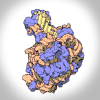 |
Ribosomal Subunits
GIF
Atomic structures of the ribosomal subunits reveal a central role for RNA in protein synthesis. Ribosomes are complex molecular machines that build proteins.
|
 |
How Enzymes Work
Video
|
| Aconitase
Video
Aconitase converts citrate into isocitrate as part of the citric acid cycle.
|
|
 |
3D Print: Alpha-amylase
Other Resource
Download curated file of Alpha-amylase for 3D printing.
|
Curriculum Resources (2)
Structural Biology Highlights (14)
Global Health (2)
| Diabetes Mellitus - DPP4
This protease is responsible for cleaving various small peptides, including the incretins GLP-1 and GIP.
|
|
| Diabetes Mellitus - Alpha glucosidase
This group of enzymes help with the final stages of carbohydrate digestion.
|
Geis Digital Archive (5)
 |
Lysozyme (488)
Geis illustrates the structure of lysozyme, the first enzyme structure revealed by X-ray crystallography. In this illustration, Geis carefully highlights the interaction between lysozyme and its substrate (red).
|
 |
Lysozyme (512)
Geis illustrates the structure of lysozyme, which was first revealed by X-ray crystallography in 1965 (Blake et al., 1965). The structure of lysozyme was the first to be determined via this method. Geis carefully highlights the interaction between lysozyme and the substrate. This particular illustration appeared on the cover of Scientific American Volume 215, Issue 5 (Phillips, 1966). |
 |
Ribonuclease S
Geis illustrates the structure of the ribonuclease S that highlights the dinucleotide RNA substrate in red and the four disulfide bonds in yellow. |
 |
Trypsin
Geis illustrates the structure of bovine trypsin, an enzyme that breaks down proteins, which was first revealed by X-ray crystallography in 1971 and further explored in 1974 (Krieger et al., 1974). This illustration was originally published in Scientific American (Stroud, 1984). Trypsin is a protease, an enzyme that catalyzes cleavage of polypeptide chains (Stroud, 1984). Geis' sketch depicts the structure with a ball-and-stick model and displays the sidechains of aspartic acid (Asp102), histidine (His57), and serine (Ser195), known as the catalytic triad.
|
 |
Aspartate Transcarbamoylase (ATCase)
In these two paintings of ATCase, Geis portrays the structural transformation between the relaxed state (R-state) and tense state (T-state). The two catalytic trimers, illustrated with tiny specks, are seen on the top and bottom, while the three regulatory dimers, depicted with thin bands, are seen on the sides and in the back. Geis utilizes movement and shading techniques to animate the transformation. The arrows on the sides of the paintings show the directions that the enzyme is rotating in each case. |
Goodsell Molecular Landscapes (4)
 |
Escherichia coli Bacterium
A cross-section through an Escherichia coli cell reveals the crowded nature of the cell and diverse molecular processes.
|
 |
Mycoplasma mycoides
Mycoplasma mycoides (2011) by David S. Goodsell. doi: 10.2210/rcsb_pdb/goodsell-gallery-011
|
 |
Biosites: Cytoplasm
Biosites: Cytoplasm (2005) by David S. Goodsell
|
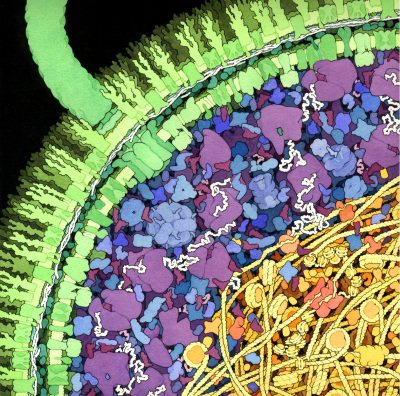 |
Escherichia coli
Escherichia coli (1999) by David S. Goodsell
|




